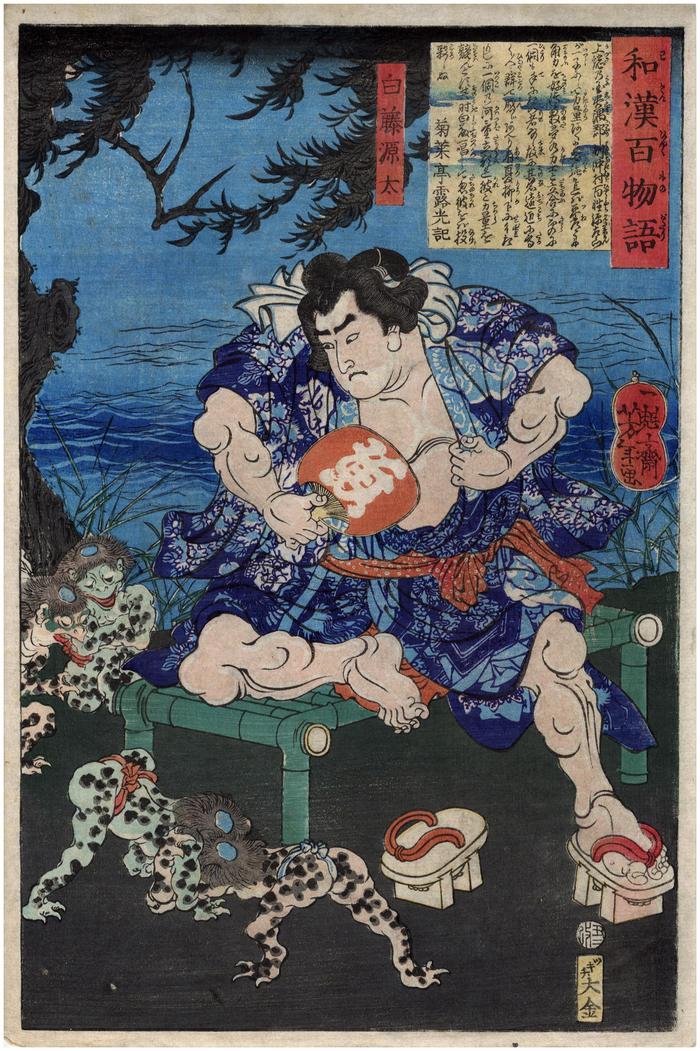Tsukioka Yoshitoshi (月岡芳年) (artist 04/30/1839 – 06/09/1892)
The sumō wrestler Shirafuji Genta (白藤源太) from the series Ghost Stories of China and Japan (Wakan hyaku monogatari - 和漢百物語)
02/1865
9.65 in x 14.37 in (Overall dimensions) Japanese color woodblock print
Signed: Ikkaisai Yoshitoshi ga
一魁斎芳年画
Publisher: Daikokuya Kinnosuke (Marks 033)
Date-censor seal: 1865, 2nd month with aratame
Museum of Fine Arts, Boston
Edo-Tokyo Museum
Waseda University
Los Angeles County Museum of Art
National Diet Library
Hagi Uragami Museum of Art
Lyon Collection - another similar print by Yoshitoshi on the same basic theme
Database of Folklore Illustrations
Ritsumeikan University - proof copy of this print
Funabashi City Library Note that Genta is sometimes spelled Genda.
****
The sumō wrestler Shirafuji Genta (白藤源太) was enjoying the cool breeze on a river bank. 'Kappa' (half humanoid and half turtle monsters who live in rivers) appeared and wanted to challenge him to a sumō wrestling match. From the series The One Hundred Ghost Stories from Japan and China (Wakan Hyaku Monogatari (和漢百物語).
The text in the large, pale yellow and blue cartouche in the upper right was written by Kikubatei Tōkō and reads: "He was a son of a farmer named Genzaemon of Haneoki village in the Esumi region of Kazusa country [present-day Gunma prefecture]. Being extremely strong, he loved sumo wrestling and had bouts with numerous famous sumo wrestlers. Nobody could defeat him. His fame spread widely and wherever people gathered they talked about him with admiration. One summer, when he was standing under a willow tree, a kappa appeared and wanted to compare its strength with Shirafuji's. Shirafuji roared at the kappa, threw it down and killed it."
This is quoted from: Yoshitoshi's Strange Tales by John Stevenson, p. 50.
Stevenson continues: "Shirafuji Genta was a well-known Sumo wrestler during the Edo period who became a kyokaku, hired bodyguard, known for his great strength and firm convictions. Here, in a more benign image than that described in the text, he watches a pair of little kappa, water creatures, wrestle, as kappa love to do. With his uchiwa fan, rather like a Sumo umpire's ceremonial fan, he looks as if he is refereeing the bout. It is summer, and the muscular Genta sits on a bamboo bench under a willow tree by a cool riverbank with his cotton yukata thrown open. His hairstyle is called ōichō, big ginko leaf, still used by Sumo wrestlers today. His pose, with one leg doubled under him, became associated with the Suikoden hero Kumonryū, literally Nine Dragons Tattoo, as illustrated by Hokusai in a Suikoden novel. The pattern on Genta's yukata appears to be Kumonryū in a wrestling pose among summer peonies, and here Yoshitoshi was probably drawing a parallel for his viewers between Genta and Kumonryū. He used most of the same details when he designed a print of a heavily tattooed Kumonryū in One Hundred Phases of the Moon in 1885 (number 6). Toyokuni also designed a print on Genta and the kappa, and his story was made into a popular Kabuki play titled Otoshi Denbei."
****
Also illustrated in color in a full-page reproduction in Japanese Yōkai and Other Supernatural Beings: Authentic Paintings and Prints of 100 Ghosts, Demons, Monsters and Magicians by Andreas Marks, Tuttle Publishing, 2023, p. 63.
****
The text reads: 上総の国夷隅郡刎沖村百性源右衛門が一子にして力量あくまで強ければ平常に角力を好つゝ数多の力士と立合に更に一個も手にたつ者なし 故に其名遠近に高く人々群て感じあへり 有夏柳下に佇たりしに 一個の河童立顕れ彼と力量を競んとす 其時白藤一唱して忽彼をば投殺しぬ 菊葉亭露光記
Yūrei-zu (幽霊図 - ghosts demons monsters and spirits) (genre)
warrior prints (musha-e - 武者絵) (genre)
sumō (相撲) (genre)
Daikokuya Kinnosuke (大黒屋金之助) (publisher)
